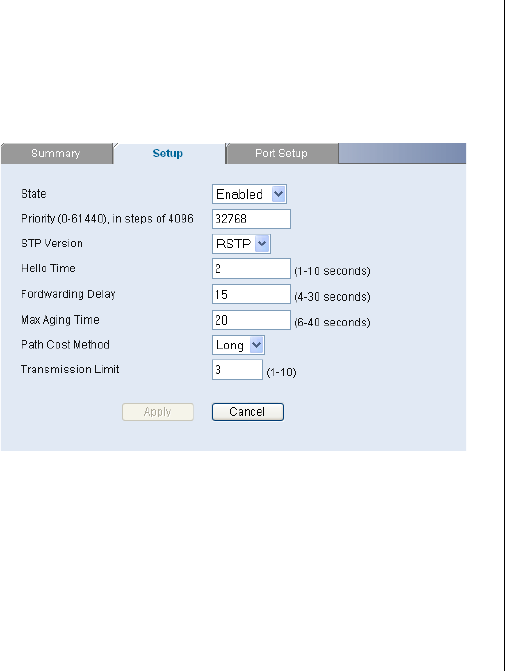
Configuring VLANs 53
Setup
To use spanning tree, use the Setup tab and choose
Enabled from the State drop down menu, fill in the
setup parameters, and click Apply.
Figure 41 Spanning Tree Setup Screen
Port Setup
This administrative tool supports the configuration of
the Switch to forward, or block and discard 802.1D
spanning tree BPDU packets.
Spanning tree is a bridge-based system for providing
fault tolerance on networks and can be used to detect
and disable network loops. The spanning tree ensures
that the optimal path is maintained between spanning
tree-compliant networked devices by:
■ Disabling redundant paths when the main paths are
operational.
■ Enabling redundant paths if the main paths fail.
Spanning tree uses a distributed algorithm to select a
bridging device that serves as the root of the spanning
tree network. The bridging device, known as the Root
Bridge, generates BPDUs (Bridge Protocol Data Units) on
all ports at a regular interval, known as the Hello Time.
All other spanning tree-compliant devices on the
network have a designated Root Port. This is the Port
nearest the Root Bridge and it is used for receiving the
BPDUs initiated by the Root Bridge. If a bridge does not
get a Hello BPDU after a predetermined interval, the
bridge assumes that the link to the Root Bridge is down.
This bridge will then initiate negotiations with other
bridges to reconfigure the network to re-establish a
valid network topology.
After all the bridges on the network have determined
the configuration of their ports, each bridge only
forwards traffic between the Root Port and the ports
that are the Designated Bridge Ports for each network
segment. All other ports are blocked, which means that
they are prevented from forwarding traffic.
Use the Port Setup tab to configure the spanning tree
settings for each port. The following options are
available:


















